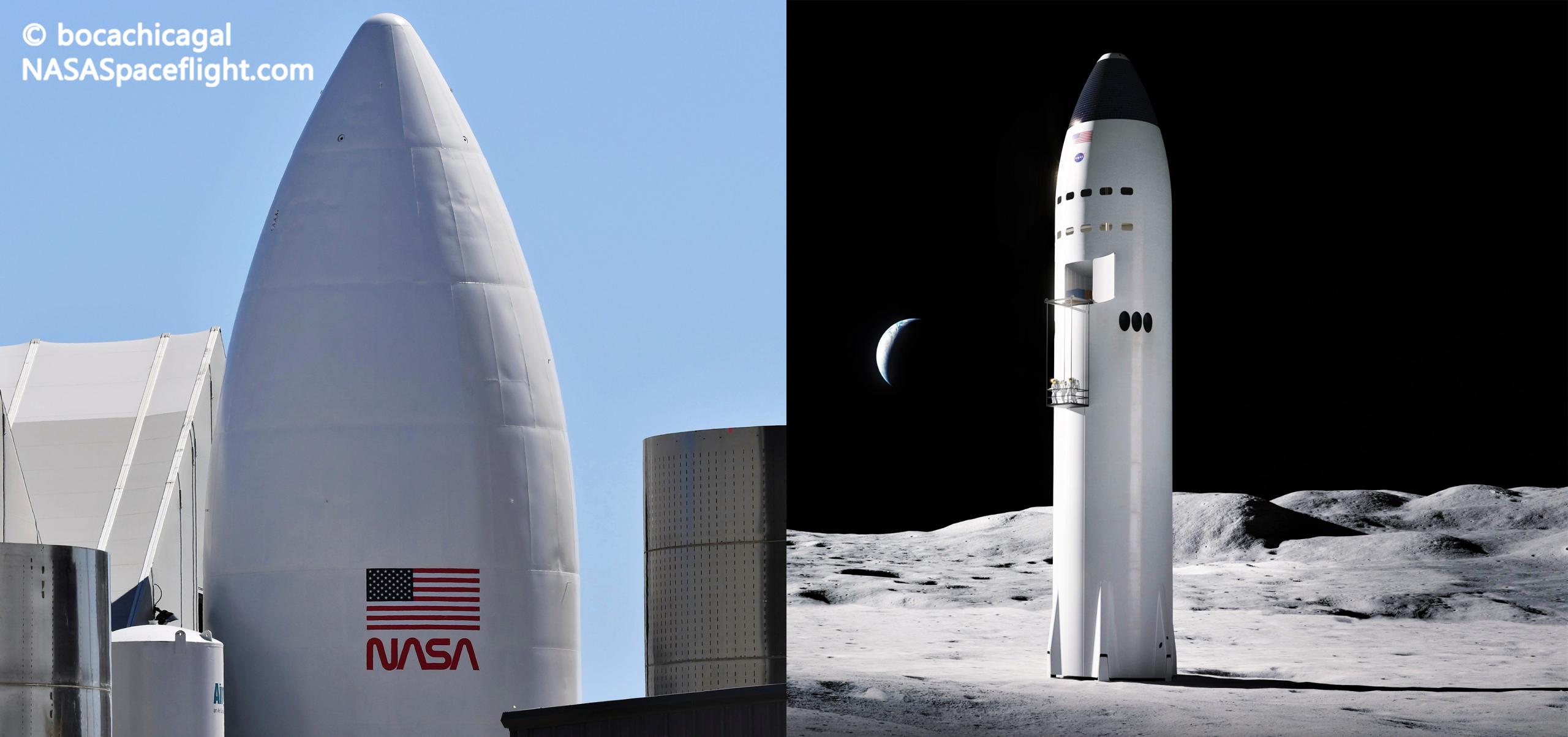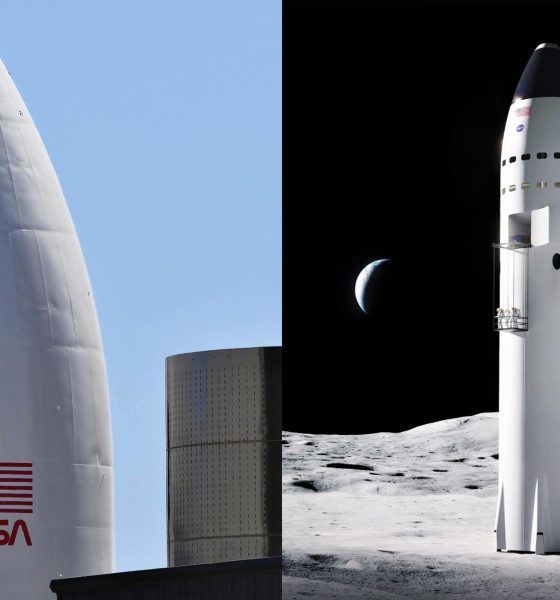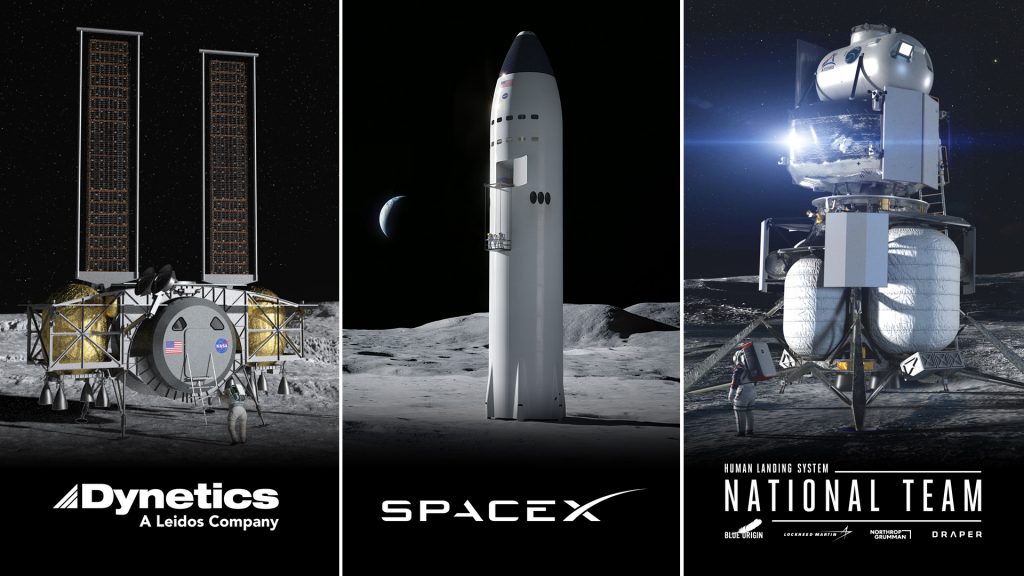

News
SpaceX eyes multiple Starship lunar landings before first NASA Moon mission
SpaceX Director Nick Cummings says that the company could potentially attempt multiple uncrewed Starship lunar landings before the first attempt at landing NASA astronauts on the Moon.
In April 2020, NASA announced the first commercial contract recipients under its new Human Landing System (HLS) program, awarding almost $1 billion in an uneven split between Dynetics, Blue Origin’s “National Team”, and SpaceX. While an undeniable boon for Dynetics, SpaceX’s inclusion arguably came as the biggest surprise, marking NASA’s first serious investment in Starship – the company’s next-generation, fully-reusable launch vehicle.
NASA’s goal: develop one or more competing human-rated Moon landers capable of landing astronauts on the lunar surface and safely returning them to an Orion spacecraft in lunar orbit. Towards that end, the space agency awarded Blue Origin’s “National Team” (including Draper, Lockheed Martin, and Northrop Grumman) $567 million to develop a massive and complex three-stage system, using Blue Origin’s conceptual Blue Moon lander for the final descent stage. Dynetics received $253 million to build a slightly simple single-stage lander, while SpaceX received $135 million to work on a single-stage Starship-derived vehicle.

It’s never been entirely clear what returns NASA expects from its initial ~$970 million investment – no trivial sum. It’s also unclear why there is such a discrepancy between the three rewards. Regardless, as of October 2020, all three competitors have successfully passed what NASA describes as a certification baseline review (CBR), laying out explicit deliverables (“acceptance criteria and products”).*
*As a side-note, if the three contracts NASA awarded involve the same deliverables, the space agency’s first HLS awards serve as yet another reminder that SpaceX’s competitors are almost inconceivably inefficient – almost 2x cheaper than Dynetics and more than 4x cheaper than Blue Origin, Lockheed Martin, Northrop Grumman, et al.
Regardless, one thing is abundantly clear: whether or not NASA’s first phase of HLS rewards anticipated it, SpaceX is the only provider performing actual integrated tests with full-scale Starship prototypes. Since NASA’s April 30th award, SpaceX has successfully completed two hop tests with two separate full-scale Starships, powered by a single off-center Raptor engine that may already serve as a real-world demonstration for a strategy SpaceX could use to gently land Starships on the Moon.
In an intriguing change of pace, NASA says that it will ultimately downselect to two of its three prospective providers, whereas past messaging has heavily implied that more than one winner was extremely unlikely. The space agency now wants to make that decision no earlier than Spring (i.e. April) 2021 with the intention of awarding contracts for demonstration flights from both providers: one to fly in 2024 and the other in 2025.

Meanwhile, over the last several months, Dynetics and Blue Origin have made significant noise over their respective reveals of what essentially amount to toy-like mockups of their proposed Moon lander systems. Blue Origin is technically making good progress testing Blue Moon’s BE-7 engine, but that’s the full extent of known hardware in work between both the National Team and Dynetics. SpaceX, on the other hand, appears to be assembling some kind of Lunar Starship mockup out of real hardware, including an off-spec steel nose and – potentially – one of two functional, flight-proven Starship prototypes. The company has also built and tested no less than 39 full-scale Raptor engine prototypes in the last ~18 months.
Ultimately, all three providers have now confirmed that in the event of winning flight test contracts, they are explicitly planning at least one uncrewed Moon landing before attempting to deliver NASA astronauts to and from the lunar surface. If NASA manages to secure future HLS funding from Congress, the next several years are bound to be jam-packed with lunar spaceflight development and exploration.

News
Tesla FSD fleet is nearing 7 billion total miles, including 2.5 billion city miles
As can be seen on Tesla’s official FSD webpage, vehicles equipped with the system have now navigated over 6.99 billion miles.

Tesla’s Full Self-Driving (Supervised) fleet is closing in on almost 7 billion total miles driven, as per data posted by the company on its official FSD webpage.
These figures hint at the massive scale of data fueling Tesla’s rapid FSD improvements, which have been quite notable as of late.
FSD mileage milestones
As can be seen on Tesla’s official FSD webpage, vehicles equipped with the system have now navigated over 6.99 billion miles. Tesla owner and avid FSD tester Whole Mars Catalog also shared a screenshot indicating that from the nearly 7 billion miles traveled by the FSD fleet, more than 2.5 billion miles were driven inside cities.
City miles are particularly valuable for complex urban scenarios like unprotected turns, pedestrian interactions, and traffic lights. This is also the difference-maker for FSD, as only complex solutions, such as Waymo’s self-driving taxis, operate similarly on inner-city streets. And even then, incidents such as the San Francisco blackouts have proven challenging for sensor-rich vehicles like Waymos.
Tesla’s data edge
Tesla has a number of advantages in the autonomous vehicle sector, one of which is the size of its fleet and the number of vehicles training FSD on real-world roads. Tesla’s nearly 7 billion FSD miles then allow the company to roll out updates that make its vehicles behave like they are being driven by experienced drivers, even if they are operating on their own.
So notable are Tesla’s improvements to FSD that NVIDIA Director of Robotics Jim Fan, after experiencing FSD v14, noted that the system is the first AI that passes what he described as a “Physical Turing Test.”
“Despite knowing exactly how robot learning works, I still find it magical watching the steering wheel turn by itself. First it feels surreal, next it becomes routine. Then, like the smartphone, taking it away actively hurts. This is how humanity gets rewired and glued to god-like technologies,” Fan wrote in a post on X.
News
Tesla starts showing how FSD will change lives in Europe
Local officials tested the system on narrow country roads and were impressed by FSD’s smooth, human-like driving, with some calling the service a game-changer for everyday life in areas that are far from urban centers.

Tesla has launched Europe’s first public shuttle service using Full Self-Driving (Supervised) in the rural Eifelkreis Bitburg-Prüm region of Germany, demonstrating how the technology can restore independence and mobility for people who struggle with limited transport options.
Local officials tested the system on narrow country roads and were impressed by FSD’s smooth, human-like driving, with some calling the service a game-changer for everyday life in areas that are far from urban centers.
Officials see real impact on rural residents
Arzfeld Mayor Johannes Kuhl and District Administrator Andreas Kruppert personally tested the Tesla shuttle service. This allowed them to see just how well FSD navigated winding lanes and rural roads confidently. Kruppert said, “Autonomous driving sounds like science fiction to many, but we simply see here that it works totally well in rural regions too.” Kuhl, for his part, also noted that FSD “feels like a very experienced driver.”
The pilot complements the area’s “Citizen Bus” program, which provides on-demand rides for elderly residents who can no longer drive themselves. Tesla Europe shared a video of a demonstration of the service, highlighting how FSD gives people their freedom back, even in places where public transport is not as prevalent.
What the Ministry for Economic Affairs and Transport says
Rhineland-Palatinate’s Minister Daniela Schmitt supported the project, praising the collaboration that made this “first of its kind in Europe” possible. As per the ministry, the rural rollout for the service shows FSD’s potential beyond major cities, and it delivers tangible benefits like grocery runs, doctor visits, and social connections for isolated residents.
“Reliable and flexible mobility is especially vital in rural areas. With the launch of a shuttle service using self-driving vehicles (FSD supervised) by Tesla in the Eifelkreis Bitburg-Prüm, an innovative pilot project is now getting underway that complements local community bus services. It is the first project of its kind in Europe.
“The result is a real gain for rural mobility: greater accessibility, more flexibility and tangible benefits for everyday life. A strong signal for innovation, cooperation and future-oriented mobility beyond urban centers,” the ministry wrote in a LinkedIn post.
News
Tesla China quietly posts Robotaxi-related job listing
Tesla China is currently seeking a Low Voltage Electrical Engineer to work on circuit board design for the company’s autonomous vehicles.

Tesla has posted a new job listing in Shanghai explicitly tied to its Robotaxi program, fueling speculation that the company is preparing to launch its dedicated autonomous ride-hailing service in China.
As noted in the listing, Tesla China is currently seeking a Low Voltage Electrical Engineer to work on circuit board design for the company’s autonomous vehicles.
Robotaxi-specific role
The listing, which was shared on social media platform X by industry watcher @tslaming, suggested that Tesla China is looking to fill the role urgently. The job listing itself specifically mentions that the person hired for the role will be working on the Low Voltage Hardware team, which would design the circuit boards that would serve as the nervous system of the Robotaxi.
Key tasks for the role, as indicated in the job listing, include collaboration with PCB layout, firmware, mechanical, program management, and validation teams, among other responsibilities. The role is based in Shanghai.
China Robotaxi launch
China represents a massive potential market for robotaxis, with its dense urban centers and supportive policies in select cities. Tesla has limited permission to roll out FSD in the country, though despite this, its vehicles have been hailed as among the best in the market when it comes to autonomous features. So far, at least, it appears that China supports Tesla’s FSD and Robotaxi rollout.
This was hinted at in November, when Tesla brought the Cybercab to the 8th China International Import Expo (CIIE) in Shanghai, marking the first time that the autonomous two-seater was brought to the Asia-Pacific region. The vehicle, despite not having a release date in China, received a significant amount of interest among the event’s attendees.








